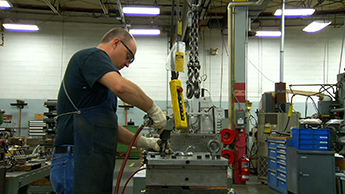 Related Articles
Related Articles

Ohio Manufacturing Workers Call Off Strike,
|
 |
Ohio IBEW members working for Schneider Electric recently approved a new contract following a two-week strike. |
More than 240 members of Oxford, Ohio, Local 2287 went on strike Oct. 5 after rejecting the company’s final contract offer – which included wage increases they deemed were insufficient to meet rising health care costs.
“It was a strong ‘yes’ vote,” said Randal Middleton, who helped lead negotiations for union employees of the France-based multinational company. Middleton is the director of the IBEW’s Manufacturing Department. “The striking members are proud of what they won.”
The company agreed to a 3-percent wage increase the first year of the agreement for veteran employees, with 2-percent raises the following two years. For those newer, younger members below the median hourly pay rate of about $21, wage increases for the first year of the agreement will be even higher.
Employees will also receive a $1,600 lump sum payment and $300 annually to apply to health care expenses.
The agreement freezes the traditional defined benefit pensions for senior members as of Dec. 31, 2015. But negotiators secured higher 401(k) contributions than the company had initially proposed. Employees now receive at least an automatic 4-percent contribution from the company, with the company matching a portion of what workers pay themselves. Employees who are closer to retirement will receive an 8-percent total contribution from Schneider.
The 3-year agreement expires in 2017.
“We’re glad this is all over,” said Local 2287 Business Manager Dennis Helton, who worked at the facility for 36 years. “We had a couple of members cross the picket line, and they’re dealing with that in the plant. But for the most part, people are just ready to go back to work and be productive.”
Along with the Ohio IBEW contingent, about 320 Machinists union members in Peru, Ind., who voted to strike Oct. 5 are now covered by the new agreement.
Schneider initially refused to return to the table after the strike began. “But in my opinion, the company was hurting,” Middleton said. With hundreds of skilled union workers off the shop floor, salaried employees were tasked with making up the difference in production. “This is just a guess, but I don’t think they could meet customer orders. There was a real sense of urgency when they called us back to the table to talk.”
Union negotiators met with Schneider executives in Chicago for a marathon two-day bargaining session on Oct. 15 that lasted deep into the early hours of Thursday morning.
On the picket lines, workers in Ohio said that they had only witnessed one shipment of completed goods leave the facility in two weeks – about half of what is usually shipped. “That would have been what workers already built before going out on strike,” Middleton said.
In Indiana, construction on a new shipping dock had stalled when drivers delivering concrete refused to cross the workers’ picket line. A scrap hopper had also overflowed, rendering much of the workspace useless, Middleton said.
While the company had initially tried to play workers against each other, Middleton said that in agreeing to the unions’ proposals, Schneider may have sent an unintended signal to its union workforce.
“The message they’ve given is that if people want a better contract, they can win it by standing together,” Middleton said.
While that will undoubtedly raise expectations for 2017’s negotiations, Middleton said solidarity among Schneider’s unionized U.S. workforce is high.
Members are part of an eight-union coordinated bargaining committee, which includes the Teamsters and the Machinists unions. Thirteen-hundred union workers produce Schneider’s circuit breakers, panel boards, safety switches, transformers and more for residential and commercial use in the U.S., which is the company’s largest and most successful market. The employees work in Indiana, Iowa, Kentucky, Nebraska and Ohio.
While the unions bargain as one group, each local union votes separately on whether to accept or reject a contract. Two IBEW local unions – Lexington, Ky., Local 2220 and Lincoln, Neb., Local 2366 – had already voted to accept the company’s offer, despite taking concessions, said Middleton.
A group of Lincoln Local 2366 members passed the hat at their hall the week of the strike, then drove to Ohio and Indiana to disperse about $3,400 in donations to those on the picket line. Leaders at Lexington Local 2220 also gave about $4,000 to the striking IBEW and Machinists union members.
Schneider Electric netted more than $2 billion in profits last year. Chairman and CEO Jean-Pascal Tricoire took home more than $6 million in executive compensation during fiscal year 2013, Businessweek.com reported. Since he took over operations in 2006, sales have risen 90 percent and company earnings have more than doubled.
So why the hostility toward its American workers?
“In a word, greed,” Middleton said. “The way to make more money is to spend less on wages and benefits. It’s a matter of taking it because they can.”
Helton said that what Schneider did during negotiations is unfortunately nothing new. “They tend to just follow behind what other companies do and go the same path,” he said. “So if other big companies are taking gains away from workers, that becomes their priority too.”
Related news:
New England FairPoint Members Strike
Union Busting Stalls Wage Growth
![]()